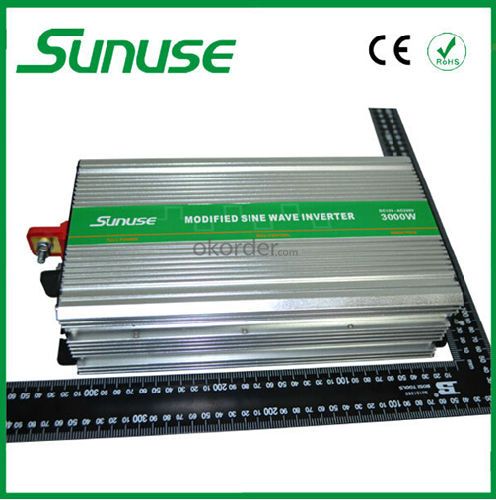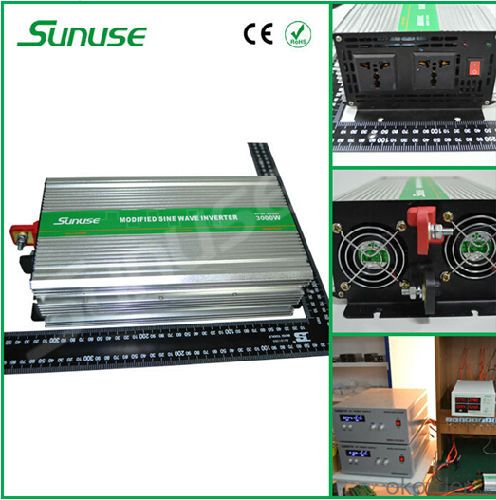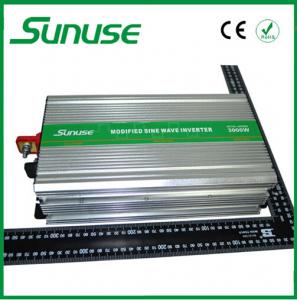Solar Sine Wave Inverter 24v 230v 3000w Dc To Ac Inverter Supply For Power Pank
- Loading Port:
- China main port
- Payment Terms:
- TT or LC
- Min Order Qty:
- 15000 watt
- Supply Capability:
- 3000000 watt/month
OKorder Service Pledge
OKorder Financial Service
You Might Also Like
1. Structure of Solar Sine Wave Inverter 24v 230v 3000w Dc To Ac Inverter Supply For
Power Pank Description
A solar inverter, or PV inverter, or Solar converter, converts the variable direct current (DC) output of a photovoltaic (PV) solar panel into a
utility frequency alternating current (AC) that can be fed into a commercial electrical grid or used by a local, off-grid electrical network. It is a
critical BOS–component in a photovoltaic system, allowing the use of ordinary AC-powered equipment. Solar inverters have special
functions adapted for use with photovoltaic arrays, including maximum power point tracking and anti-islanding protection.
2. Main Features of Solar Sine Wave Inverter 24v 230v 3000w Dc To Ac Inverter Supply
For Power Pank
• High temperature protection:
Such as inverter internal temperature or ambient temperature is too high, machine will begin to open the high temperature protection
machine to stop working, and protect the safety of electrical equipment.
•Low voltage protection:
When the battery or power supply voltage is too low, the inverter will automatically shutdown protection, stop output in order to protect the
storage battery or power supply.When the voltage returns to normal, the inverter automatically return to work.
•High voltage protection:
When the battery or power supply voltage is too high, the inverter will automatically shutdown protection, stop output in order to protect the
storage battery or power supply.When the voltage returns to normal, the inverter automatically return to work.
•Overload protection:
When the connection of the loaded beyond the rated power of the inverter, the inverter will automatically be turned off to stop the output
.After removal of overload, automatically return to normal work.
•Short circuit protection:
When there is serious fault connected load, the inverter will automatically shutdown stop output, after removal of short circuit, automatic back
to normal work.
3. Power Inverter with Solar Sine Wave Inverter 24v 230v 3000w Dc To Ac Inverter
Supply For Power Pank Images



4. Solar Sine Wave Inverter 24v 230v 3000w Dc To Ac Inverter Supply For Power Pank
Specification
Item: | 3000W 12V | 3000W 24V | 3000W 48V |
Input DC Voltage Range: | 11-16V DC | 22-32V DC | 44-62V DC |
Under-voltage Protective: | 10.0±0.3V DC | 20.0±0.8V DC | 40.0±1.5V DC |
Under-voltage Alarm: | 10.5±0.3V DC | 21.0±0.8V DC | 42.0±1.5V DC |
Over Voltage Protective: | 16.0±0.3V DC | 31.0±0.8V DC | 62.0±1.5V DC |
Over Voltage Recovery: | 15.0±0.3V DC | 29.0±0.8V DC | 59.0±1.5V DC |
Max Power: | 3000W Modified sine wave inverter ac220v | ||
Peak Power: | 6000W | ||
Package: | White box package | ||
USB: | 2000mA | ||
Reverse Protecion: | Blown fuses | ||
Over Load Protection Power: | 110%-120% | ||
Quiescent Current: | ≤0.1A~0.6A | ||
Max. Efficiency: | ≥92% | ||
Total Harmonic Distortion: | ≤3% Linear load(modified sine wave) | ||
Short Circuit: | YES | ||
Status Indicator Lamp: | Work: Green LED Failure: Red LED and alarm | ||
LED Display: Voltage, Current, Power(optional) | |||
Work condition: | Operating Temperature: -10~40°C | ||
Opetating Humidity: 10--90%(non-condensate) | |||
5. FAQ of Solar Sine Wave Inverter 24v 230v 3000w Dc To Ac Inverter Supply For Power
Pank
Q1:Can we visit your factory?
A1:Sure,welcome at any time,seeing is believing.
Q2:Which payment terms can you accept?
A2:T/T,L/C,Moneygram,Paypal are available for us.
- Q:Is it possible to upgrade my existing solar inverter without replacing the entire system?
- Yes, it is possible to upgrade an existing solar inverter without replacing the entire system. In many cases, inverters can be easily replaced or upgraded to newer models that offer improved functionalities or higher performance. However, it is important to consult with a professional solar installer to ensure compatibility and feasibility before making any changes to the existing system.
- Q:What is the power factor of a solar inverter?
- The power factor of a solar inverter refers to the ratio between the real power and the apparent power. It indicates how effectively the inverter converts the DC power generated by solar panels into AC power. A high power factor (close to 1) indicates efficient power conversion, while a low power factor (close to 0) signifies poor conversion efficiency.
- Q:How do you calculate the efficiency of a solar inverter?
- To calculate the efficiency of a solar inverter, you need to divide the output power by the input power and multiply it by 100. The formula is: Efficiency = (Output Power / Input Power) * 100.
- Q:Can a solar inverter be used with a solar-powered emergency lighting system?
- Yes, a solar inverter can be used with a solar-powered emergency lighting system. The solar inverter is responsible for converting the DC (direct current) power generated by the solar panels into AC (alternating current) power that can be used to power the emergency lighting system. This allows the system to store excess energy in batteries and provide uninterrupted power during emergency situations.
- Q:How does a solar inverter handle different temperature conditions?
- A solar inverter is designed to handle different temperature conditions by employing various thermal management techniques. It typically has built-in cooling systems such as fans or heat sinks to dissipate excess heat. Additionally, advanced inverters may employ temperature sensors to monitor the internal temperature and adjust their operations accordingly. These temperature compensation features allow the inverter to maintain optimal performance and efficiency across a wide range of temperature conditions.
- Q:What are the common issues and troubleshooting steps for a solar inverter?
- Some common issues with solar inverters include no power output, low power output, display or communication errors, and overheating. Troubleshooting steps for these issues may involve checking the input voltage and connections, inspecting the DC and AC cables for damage, resetting the inverter, updating firmware or software, ensuring proper ventilation and cooling, and contacting technical support if necessary.
- Q:Can a solar inverter be used with a time-of-use electricity tariff?
- Yes, a solar inverter can be used with a time-of-use electricity tariff. A solar inverter is responsible for converting the direct current (DC) energy produced by solar panels into alternating current (AC) electricity that can be used in homes or businesses. By connecting the solar inverter to a time-of-use electricity tariff, users can take advantage of different electricity rates at different times of the day. This allows them to maximize their solar energy consumption during off-peak hours when electricity rates are lower and minimize their consumption during peak hours when rates are higher.
- Q:What is the role of a solar inverter in a solar-powered electric fence?
- The role of a solar inverter in a solar-powered electric fence is to convert the direct current (DC) electricity produced by the solar panels into alternating current (AC) electricity, which is required to power the electric fence. The solar inverter also regulates and stabilizes the voltage and frequency of the electricity to ensure proper functioning of the electric fence system.
- Q:What is the role of a grid protection relay in a solar inverter?
- The role of a grid protection relay in a solar inverter is to monitor the performance and safety of the grid connection. It helps to ensure that the solar inverter operates within the specified parameters and protects the grid from any potential issues such as overvoltage, undervoltage, or frequency deviations. The relay acts as a safeguard by quickly disconnecting the solar inverter from the grid in case of any abnormalities, preventing any damage to the inverter or the grid itself.
- Q:What is the difference between a central inverter and a string inverter?
- A central inverter is designed to convert the DC power generated by multiple solar panels into AC power at a central location. It usually handles larger power capacities and requires professional installation. On the other hand, a string inverter is installed near the solar panels and converts the DC power generated by a string or series of panels into AC power. It is typically used in smaller-scale solar installations and is easier to install and maintain.
1. Manufacturer Overview |
|
|---|---|
| Location | |
| Year Established | |
| Annual Output Value | |
| Main Markets | |
| Company Certifications | |
2. Manufacturer Certificates |
|
|---|---|
| a) Certification Name | |
| Range | |
| Reference | |
| Validity Period | |
3. Manufacturer Capability |
|
|---|---|
| a)Trade Capacity | |
| Nearest Port | |
| Export Percentage | |
| No.of Employees in Trade Department | |
| Language Spoken: | |
| b)Factory Information | |
| Factory Size: | |
| No. of Production Lines | |
| Contract Manufacturing | |
| Product Price Range | |
Send your message to us
Solar Sine Wave Inverter 24v 230v 3000w Dc To Ac Inverter Supply For Power Pank
- Loading Port:
- China main port
- Payment Terms:
- TT or LC
- Min Order Qty:
- 15000 watt
- Supply Capability:
- 3000000 watt/month
OKorder Service Pledge
OKorder Financial Service
Similar products
New products
Hot products
Hot Searches
Related keywords































